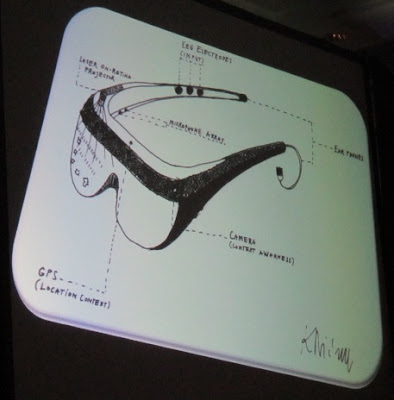A phone today is a a value-added service, a ‘teleputer,’ a creature born with genes coming from a cell phone and a personal computer,” according to independent researcher Szymon Slupik.
Speaking yesterday at the invitation-only Emerging Communications Conference & Awards (eComm), the Krakow-based futurist explained that by 2020, a mobile phone as we know it will disappear, evolving into a device linking our senses directly with senses of other people or with machines. What device will displace the role of today’s smartphone: Internet glasses.

“Voice was always organized in sessions with a beginning and an end. Today we have threads. So when a thread is started it never ends and we have many continuing in parallel. Think of your email, RSS feeds, Twitter, etc. So this is how our brain works. The phone of tomorrow will be telecoupling us and machines,” Slupik said. This is analogous to acoustic coupling, information will be transmitted directly to our brains via wireless gateways.
So how do we get there and when? The key, said Slupik, is to bypass tiny screens and keyboards altogether and look to emerging technologies that can free up the bandwidth bottlenecks caused by aging paradigms. Think “screenless instead of better screens. Touchless instead of better touch.” The two key technologies:
- Laser based displays - MEMS (microelectromechanical systems)-based laser projectors can display images directly on our retinas while not blocking our sight, enabling mixed reality vision. The beauty is that it is so small that it can already be integrated into eyeglasses.
- Brain waves sensing - We need to control the functions by the mind to become really hands free. Aided by eye tracking, direct brain links will provide touchless input. Sound far fetched? It’s not. Major universities continually report progress with brain implants used in lab rats and humans, while commercial applications for noninvasive coupling with human brain signals are also emerging. A Japanese company recently announced cat ears that can be worn on the human head and manipulated with nothing but the mind.
Slupik believes that we are on the verge of a hardware revolution that will allow for computer senses and the brain to be networked by the end of this decade. The result will be an unleashing of unimaginable usage scenarios. Computers in the cloud will be fully aware of our context, receiving a continuous stream of what we hear and what we look at and, in turn, sending us back contextually-aware information, such as hints, translations, and guidance.
After his talk, Slupik gave me another example. Imagine remotely flying a drone equipped with a camera somewhere in Australia and being able to see the image projected on your eyeglasses. In effect, you’ll will be able to hear with somebody else’s ears and see with somebody else’s eyes.
S:www.zdnet.com


EmoticonEmoticon